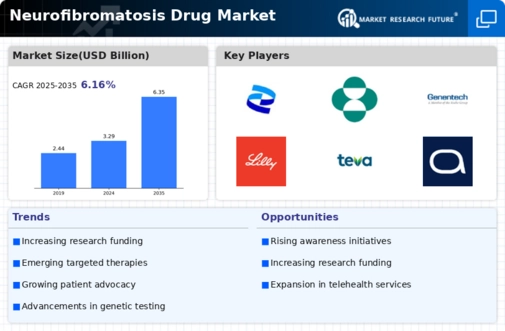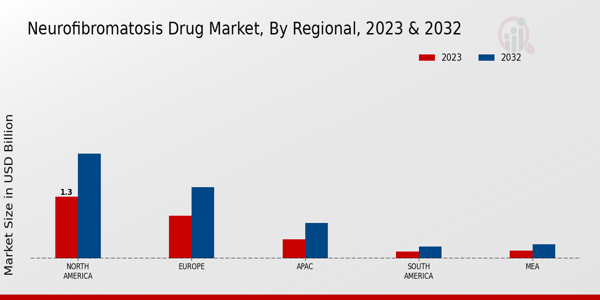Market Growth Projections
The Global Neurofibromatosis Drug Market Industry is projected to experience substantial growth, with forecasts indicating a rise from 3.29 USD Billion in 2024 to 6.35 USD Billion by 2035. This growth trajectory reflects a compound annual growth rate (CAGR) of 6.16% from 2025 to 2035. Such projections underscore the increasing demand for effective treatments and the ongoing advancements in drug development. The market dynamics are influenced by various factors, including rising prevalence, increased research funding, and regulatory support, all contributing to a robust growth outlook for the industry.
Increased Research Funding
The surge in research funding dedicated to neurofibromatosis is a notable driver for the Global Neurofibromatosis Drug Market Industry. Government and private organizations are increasingly recognizing the need for research into this condition, leading to enhanced funding opportunities. For example, the National Institutes of Health has allocated substantial resources to neurofibromatosis research, fostering the development of new therapies. This influx of funding supports clinical trials and the exploration of novel treatment modalities, thereby accelerating the pace of drug development. Consequently, the market is poised for growth, with a projected CAGR of 6.16% from 2025 to 2035.
Growing Awareness and Advocacy
Growing awareness and advocacy for neurofibromatosis are significantly influencing the Global Neurofibromatosis Drug Market Industry. Organizations dedicated to raising awareness about the condition are playing a pivotal role in educating the public and healthcare professionals. This increased awareness leads to earlier diagnosis and treatment, which is essential for improving patient outcomes. Advocacy groups are also instrumental in lobbying for research funding and policy changes that support the development of new therapies. As awareness continues to expand, the demand for effective treatments is likely to rise, further driving market growth.
Advancements in Drug Development
Recent advancements in drug development methodologies are propelling the Global Neurofibromatosis Drug Market Industry forward. Innovative approaches, including targeted therapies and personalized medicine, are being explored to enhance treatment efficacy and minimize side effects. For instance, the development of drugs like selumetinib has shown promise in clinical trials, indicating a shift towards more effective treatment options. These advancements not only improve patient outcomes but also attract investment and research funding, which is crucial for further innovation. As a result, the market is expected to grow significantly, with projections indicating a rise to 6.35 USD Billion by 2035.
Regulatory Support for Drug Approvals
Regulatory support for expedited drug approvals is a vital driver for the Global Neurofibromatosis Drug Market Industry. Regulatory agencies, such as the FDA, have implemented programs to facilitate the development of therapies for rare diseases, including neurofibromatosis. These initiatives, such as orphan drug designations and fast-track approvals, encourage pharmaceutical companies to invest in research and development. By streamlining the approval process, these regulations help bring new treatments to market more quickly, addressing the urgent needs of patients. This supportive regulatory environment is likely to enhance market growth and innovation in the coming years.
Rising Prevalence of Neurofibromatosis
The increasing prevalence of neurofibromatosis globally is a critical driver for the Global Neurofibromatosis Drug Market Industry. According to estimates, neurofibromatosis affects approximately 1 in 3,000 individuals, leading to a significant patient population in need of effective treatments. This growing number of patients necessitates the development and availability of specialized drugs, thereby expanding the market. As awareness and diagnosis improve, more individuals are identified, which further fuels demand for therapeutic options. The market is projected to reach 3.29 USD Billion in 2024, reflecting the urgent need for innovative treatments to address this condition.


























